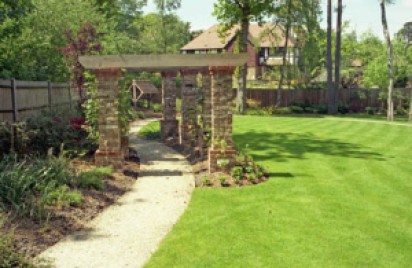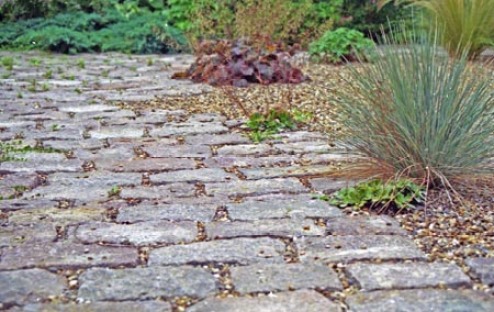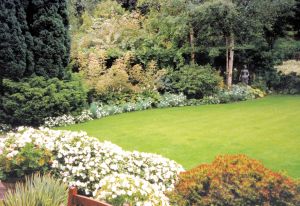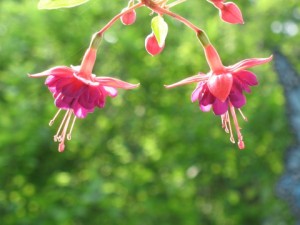-
Paths in your Garden
Paths have been around awhile.
Granite sett path – these setts traveled from Portugal in the 1800’s as ships ballast and were then used on London’s streets.
They were a very convenient group of sizes namely ;-
- 4 inch x 4 inch x 4 inch
- 4 inch x 4 inch x 6 inch
- 4 inch x 4 inch x 8 inch
These regular sizes enable a module to be used, which makes the overall finished visual much more attractive. It’s also easier to lay – below you see a radius layout using just 4 inch x 4inch x 4inch setts.

Seeing as we have snow today, I thought it might be an idea to talk a little about paths and paving materials. Not all paving is equal as they say, concrete for instance is often more slippery than say asphalt ( there is a standard called CBR – California Bearing Ratio, this is basically a coefficient of slipperiness. Often only used for roadways and cars.)
So lets take a look at some paths

This gravel path works great, except when frost is just coming out of the surface, when it gets very sticky. Gravel paths are both attractive, economical and if laid on a suitable base long lasting, a simple rake and roll often restores the path to its near original state. Keeping on top of surface weed growth is essential.

Paths should be at least 5ft wide to allow a couple to walk side by side..although,in a garden this is often impractical.
This beautiful path leads all the way around the garden, making it a fabulous way to explore the differing views created.

This scented path uses camomile planted within the ‘p-shingle’.
We used old railway sleepers and camomile to create this pathway, the camomile grows and covers the widened joints. When you walk on the camomile a lovely scent rises up.

A more formal gravel path – this is a white limestone and approximately 4ft 6 inch wide – just wide enough for two people to stroll (promenade) around together
Here the path is dressed in graded white limestone, this creates a much more formal garden for the client.

The next is designed in a series of straight lines using a brick module.

Here a zig-zag brick path leads from one section of the garden to another Using stock bricks that compliment the house colours is a good way to ‘link’ a garden design to a house. Walking on a larger sized clean gravel, is both fun due to the noise and a safety feature as you can hear someone or something approaching.

Here we used a larger stone size to add that lovely crunching sound as you walk on the path 
Natural random rectangular stone leading to a bound gravel pathway.
Perhaps the most expensive form of path, the steps are laid in natural random rectangular stone, which is expensive to purchase and time consuming to lay..

Natural stone steps It was a hot day when they completed these steps….

Probably the best material for steps To finish with some of my favorite materials. I’ve always tried to use natural materials on projects as the colour does not fade with time, they are often long lasting – if laid correctly. They always look soft and blend in so well with the surroundings..but natural comes with a significant cost increase..
A quick word about patios, if you are using the patio for entertaining a normal table with four chairs requires an area of approximately 10ft 6 ins ( 3m) x 10ft 6 ins (3m) to accommodate the table and chairs.

Laying small unit sett paving of almost random size in a radiating pattern requires skill and patience…. Do send us a comment or a request
[contact-form-7 id=”781″ title=”Contact form 1″]
Views: 59
-
HortCuisine
-
Hello world!
How it all started, my first job.
It’s been very many moons since starting out early one morning to work ‘in the woods’ near
my home in Caversham, Reading.
Leaving the house at 6.30am, with a hoar frost on the ground, piling into the back an Austin van, joining three others who were much more able than 14 year old me.

My mum would pack a lunch for me and added a thermos flask of hot soup.
Matt, the foreman greeted me, introducing the rest of the crew, Wilf an older gentleman
with a very gruff appearance, Aleric a much younger, very well educated fellow, David, who was my age
and the son of the boss. he was also my friend.
We were only driving about 15 miles to a small village called Checkendon where the boss owned a small woodland – around 20 acres of mixed hardwood planting.
We arrived at the five bar entrance gate, the area looked like an over grown field. Then driving down a small track, that stopped at an old rectangular concrete building with just a door, no windows. Everyone piled out, and headed for the building, inside were a selection of ‘v’ shaped planting spades, a bunch of ranging poles and a large pile of plastic bags with various bare root tree species inside.
The plan this day was to complete a mixed hardwood woodland planting. The planting distances were 5ft row separations with 5 ft planting gaps.
Views: 7
-
The Cancer Survivor’s Garden Companion

Ann and I were fortunate to interview Jenny Peterson, just after her new book was published. Jenny is an amazing, extremely positive lady who is an inspiration for us all.
A Garden that Heals.
Pittsburgh, Pa. (October 5, 2015): When Jenny Peterson was diagnosed with breast cancer in 2012, it rocked her world. Her cancer treatment was hard, emotional and often deeply depressing. But Peterson, a garden designer and Master Gardener, did not let the cancer diagnosis define her. She used her desire to garden and dig in the dirt again to pull her out of the darkness. And she discovered that gardening is good medicine –for the body, mind and spirit.
The Cancer Survivor’s Garden Companion:
Cultivating Hope, Healing and Joy in the Ground Beneath Your Feet
(St. Lynn’s Press, January 2016) tells Peterson’s story and explores the therapeutic benefits of this vital “earth connection,” including inspirational profiles of other cancer survivors, both men and women, whose gardens became their partners in healing.With gentle empathy, beautiful photographs and easy how-to steps. Peterson shows others how to create their own backyard haven for healing – a personal restorative garden – with well-grounded guidance about diet, exercise, mental focus and spiritual renewal. Her book adds a fresh voice to the growing fields of horticultural therapy and therapeutic gardens.
What others are saying about The Cancer Survivor’s Garden Companion:
“Jenny’s tips for incorporating gardening into your life for mind, body, and spiritual health are ingenious!
What other authors are saying.
As a cancer coach, I will definitely be suggesting this book to my clients.” – Susan Gonzalez, BSN, CPCC, co-author of 100 Perks of Having Cancer Plus 100 Health Tips for Surviving It, and editor of The Savvy Sister blog
“Jenny’s beautiful book reminds us all that life can be found in the healing, meditative act of gardening. By lovingly tending a garden, we can learn to nurture ourselves, restoring our mind, body and spirit in the process.” – Ray Anne Evans, Executive Director, Breast Cancer Resource Centers of Texas
“Jenny’s connection with gardening, garden design, and simply being in nature remained strong throughout her cancer diagnosis, treatment, and recovery. In fact, it was part of what helped her through. And now she is helping others to learn from her powerful experience.” – Naomi A. Sachs, Founding Director, Therapeutic Landscapes Network; co-author, Therapeutic Landscapes: An Evidence-Based Approach to Designing Healing Gardens and Restorative Outdoor Spaces
The Cancer Survivor’s Garden Companion will teach readers how to use the garden to heal, find hope and feel joy.
About the Author.
Jenny Peterson is a landscape designer and Master Gardener specializing in xeriscaping and small urban spaces. She is a cancer survivor who found hope and healing in her garden, even during the darkest days of chemotherapy and radiation. In the process, she made deep connections with the cancer support community, including physicians, nutritionists, bodywork practitioners, psychologists and spiritual counselors.
Peterson co-authored Indoor Plant Décor: The Design Stylebook for Houseplants (St. Lynn’s Press, 2013) with Kylee Baumle. She lives in Austin, Texas, with her fiancé, 19 chickens, two dogs, two quails and a goat.
You can listen to the interview here : Interviewing Jenny Peterson
If you would like to purchase the book : The Cancer Survivors Garden Companion
Podcast: Play in new window | Download
Subscribe: RSS
Views: 148
-
The right-sized Flower Garden
Kerry Mendez has a passion for gardening, in her latest book “The right-sized Flower Garden” she discusses how to develop a garden that you can manage, often this will reduce the amount of work involved. As she explains it’s all … Continue reading
Podcast: Play in new window | Download
Subscribe: RSS
Views: 85
-
If I were opening a Garden center today
Garden Centers have evolved over the years, there are Independent Garden Centers often in a local neighborhood, there are larger groups with multiple locations.
Many of the big box ‘Do it Yourself stores’ have larger and larger ‘Garden Center’ sections.
The question recently has been where are they all heading.
So Ann asked Sid & John – “If I were to open a Garden Center today what would be your recommendations?”
Sid Raisch
CEO of Horticultural Advantage (www.AdvantageDevelopmentSystem.com) , providing business expertise and extensive leadership training to small to medium horticultural businesses, primarily retail garden centers and selected wholesale suppliers.
John Stanley.
International retail guru is what people call me. Specialising in helping retail businesses to grow their bottom line and expand their market base. I work in 26 countries with retailers of all sizes. My expertise ranges from conference speaking to hands on management consultancy. My specialist retail areas are in perishable retailing – anything that will not last long without loving care on the shelf
Sid and John discuss future trends for gardens, garden centers, and our urban environment.
This fascinating , very informative interview is going to have you thinking.
Send us your thoughts to Growing Trends
Podcast: Play in new window | Download
Subscribe: RSS
Views: 107
-
Ann visits the Chelsea Physic garden
It’s not often you find a garden that was founded in 1673 as The Apothecaries’ Garden
Ann was on a trip to Europe recently and dropped in on the beautiful Chelsea Physic Garden on the side of the river Thames in London.
The garden’s purpose was to train apprentices in identifying plants. The gardens’ location close to the river created a warmer microclimate, significantly increasing the many non-native plants that could be grown.
In 1700 the garden had started an international botanical garden seed exchange system, which continues to this day.
The gardens cover some four acres and are leased on what is known as a peppercorn rent in perpetuity.
They are without doubt one of London’s secret ‘gems’ and thoroughly worth a visit.
The garden’s mission ” Linking people with plants and nature”
The interview starts with Ann talking for around 8 minutes to a group of school children on a field trip, the gardens have over 100 such visits a year. Ann then talks to Michael a very knowledgeable and extremely helpful member of staff. We kept all the typical inner city sounds on the recording – the enthusiasm of the children is very heartening.
Integrated pest management is the preferred method of bug control…
They have a project called “Shelf Life’ it is just an incredible way to show children where their food comes from
You can also listen to Ann’s interview on iTunes at Growing Trends
We would love to hear your comments and suggestions for a show… just send us an email to Growing Trends
Podcast: Play in new window | Download
Subscribe: RSS
Views: 94
-
Growing Trends : How we look at Food Tourism today
Ann and I interviewed John Stanley of John Stanley Associates recently about his new book, he jointly wrote with his wife Linda,
Food Tourism – A Practical Marketing Guide.
The fastest growth in tourism today is the culinary sector.
Listen to John as he explains the overall direction of food tourism, including how he sees future development.
A few snip bits:
Do you grow soil?
25% of the food we buy comes from 2% of the farmland around our cities, which is being swallowed up by development.
Farmers used to make 38 cents on every dollar now its down to an average of just 6 cents
Eating local seasonal food saves you around 25%, and is actually healthier for you!
You can hear this really informative interview here (click below) or on iTunes at Growing Trends
Podcast: Play in new window | Download
Subscribe: RSS
Views: 53
-
Heaven is a Garden – Jan Johnsen
A few years ago I read a paper about how grasses ‘moved’ to music, then I read about the effects of harmonious sounds on plant growth.
Why do I mention this?
Well a few weeks ago we were talking about Tesla and his discoveries, which led us to talking about vibrations, sound waves, force fields etc., then a strange thing happened.
Ann and I interviewed a wonderful lady landscape architect Jan Johnsen, about her new book “Heaven is a Garden” we talked a little about how at a very young age she discovered during a science fair competition – which against all the odds she won – the effects early morning birds singing have on plants. The sound waves, which are similar to a violin stimulate a plant to open its stomata taking in carbon-dioxide to help it grow quicker.
Jan has written a book called Heaven is a Garden, it’s a really fascinating and informative read. Jan has ‘connected’ the dots so as to speak, between the natural world and our emotions. How the Four Winds are important when laying out a space,the careful use of curves, and my favorite Golden Rectangles and the Divine Proportion. – Phi is the mathematical proportion ( 1 : 1.618) we see in every natural form. Using this proportion ensures a sense of harmony in any outdoor space that contains it. I’ve always tried to use these proportions in my designs.
Jan then talks about Trees – natures rechargers as she puts it… The Celts shunnache, the Hindu tree devas, and Greek dryads are really references to light energy? The Chinese call this energy chi…the Japanese consider the health giving properties of trees the basis of a medical therapy called ‘ Forest bathing’, it helps reduce stress.
Jan then discusses the magnetic attraction in a Zen garden – rocks in these gardens reflect a deep understanding of the geomagnetic properties of stone and its impact on a place.
Finally the benefits of color in a garden.
You can listen to our truly fascinating interview with Jan Johnsen or if you prefer on iTunes at Growing Trends or just click on the arrow below to start the interviewWe would love to hear from you if you like this interview
Ann and Chris,
[contact-form-7 id=”781″ title=”Contact form 1″]
Podcast: Play in new window | Download
Subscribe: RSS
Views: 142
-
Did you know you can ‘Eat your Roses?’
A Gardening lover’s recipe book….
It’s that time of year again, as we move from Spring into Summer all sorts of tasty treats abound in our gardens, our interview today is with a lady who has taken this to a new dimension.
Ann & I caught up with Denise Shreiber, recently to interview her about her fascinating book, all about edible flowers.
Being a transplanted ‘Brit’ it was interesting to hear that her book was born after a trip to England where she sampled ‘Rose Petal Ice Cream’,
Here I was, under the illusion that everyone visited our wonderful gardens and stately homes for the good old English “cuppa” with perhaps a scone, butter, jam and clotted cream !
You can listen to Denise here..
It’s that time of year again, as we move from Spring into Summer all sorts of tasty treats abound in our gardens, our interview today is with a lady who has taken this to a new dimension. Ann & I … Continue reading
Podcast: Play in new window | Download
Subscribe: RSS
Views: 8
-
School Garden Projects have many positives, you can hear many of them here
Is this really salad ? it tastes so good like this !
Ann & I were fortunate to talk to three amazing ladies from Tennessee a little while ago. They wanted to start a school garden at their school, here is their story, the school garden is now in its third year.
Some of the main points we heard were:-
It’s essential to have teacher as well as parent support.
Take time to plan carefully
Initially growing from seed is harder , due to the school calendar.
Choose plants that will fit into this schedule.
The children want to take ownership of their plants !
Educating children in the different choices of produce increases the varieties they will eat.
Children really take pride in taking home to their family the produce they have grown.
In a blind radish test, the children could tell which were home grown as opposed to store bought and much preferred home grown !
Ann & I would love to hear from you. info@grotrends.com
If you would like us to put you in touch with these wonderful ladies,or if you would like more information on starting your own school garden just send us an email to Growing Trends and we will be in touch. If you would like us to interview you, send us a picture of your garden along with contact details, we will be adding a section to our web site www.grotrends.com specially on School garden projects.
Thank you Penny, Peggy and Emily, this was a fascinating interview.
Ann & Chris
Podcast: Play in new window | Download
Subscribe: RSS
Views: 55
-
Country: Growing Trends -Sustainability for the world today
Ann and Chris interview Rich Sapienza and Bill Sosinsky we talk about sustainable solutions for the world today.
It's fascinating, interesting and very enlightening.
Sustainability must work on its own, grow on its own, support itself with the built-in ability to endure and grow naturally. There must be a plan. As long as we rely on subsidies and philanthropy as the means by which we re-establish our sustainable balance on this planet, we are ultimately doomed. This lack of strategy insures we run out of sufficient monies way before we have fully addressed these essential challenges. The simple answer is that everything must work together and their needs to be a singular general vision that incorporates the best efforts of all the contributing parties
Podcast: Play in new window | Download
Subscribe: RSS
Views: 57






































